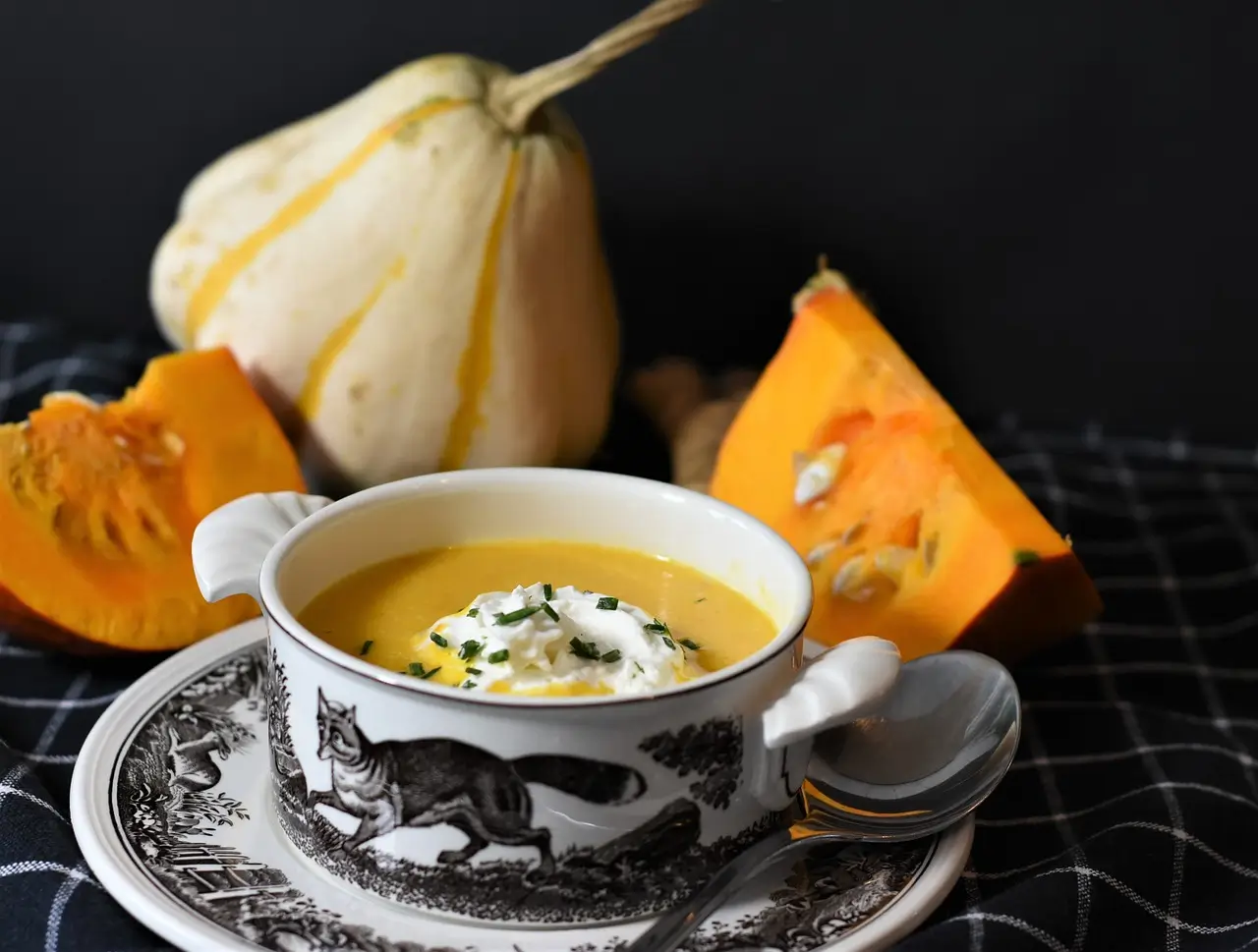A single serving of potato soup contains 594 calories and 42g of fat, but this classic comfort food can still be a guilt-free pleasure.
Golden Yukon potatoes offer a buttery texture, while starchy Russets break down perfectly. The ideal potato soup recipe depends on proper technique. You can make a delicious homemade potato soup that serves 8-10 people with just 20 minutes of prep time.
Making the perfect creamy texture and preventing dairy separation can be challenging. Our professional tips and techniques will help you become skilled at making this comforting dish. Let’s explore our chef-approved recipe that turns simple ingredients like potatoes, chicken broth, and cream into a bowl of pure comfort.
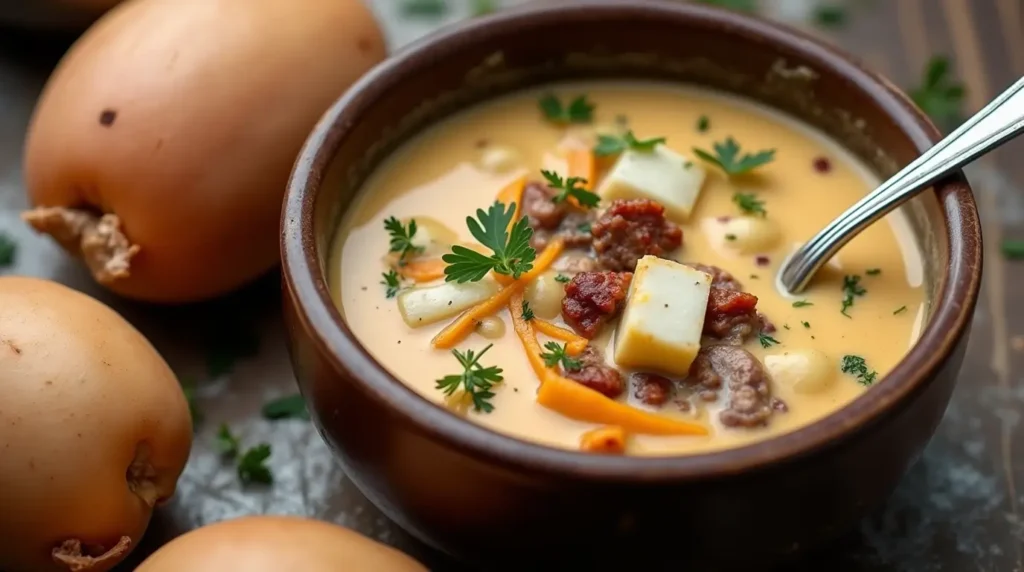
Table of Contents
Essential Ingredients for the Perfect Potato Soup
Quality ingredients are the key to making a successful potato soup recipe. Each ingredient plays a significant role in creating that perfect bowl, starting from potato selection to the base stock.
Choosing the Right Potato Varieties
Russet potatoes are the top choice to make creamy potato soup. These high-starch, low-moisture potatoes break down easily while cooking and thicken your soup naturally. Yukon Gold potatoes provide a buttery texture and maintain their shape better, which makes them great for chunkier soup.
Stock and Base Ingredients
Quality stock creates the soup’s flavorful foundation. Low-sodium chicken broth makes a traditional base that lets you control salt levels better. Vegetable stock works equally well for vegetarian versions.
The soup’s signature velvety texture comes from mixing whole milk and heavy cream. All-purpose flour helps thicken the soup and gives it a luxurious consistency. Diced onions, minced garlic, and celery are the essential aromatics that create the soup’s savory foundation.
Optional Add-ins and Toppings
You can turn your simple potato soup into a customizable feast with these classic toppings:
- Dairy additions: Sharp cheddar cheese, sour cream, or fresh parmesan
- Protein elements: Crispy bacon bits or diced ham
- Fresh elements: Sliced green onions, chives, or steamed broccoli florets
The best time to add sour cream is at the final stage to avoid curdling. Nutritional yeast gives a cheesy flavor without dairy in vegetarian versions. Steamed broccoli florets or corn kernels can boost the soup’s texture nicely.
Professional Techniques for Creamy Potato Soup
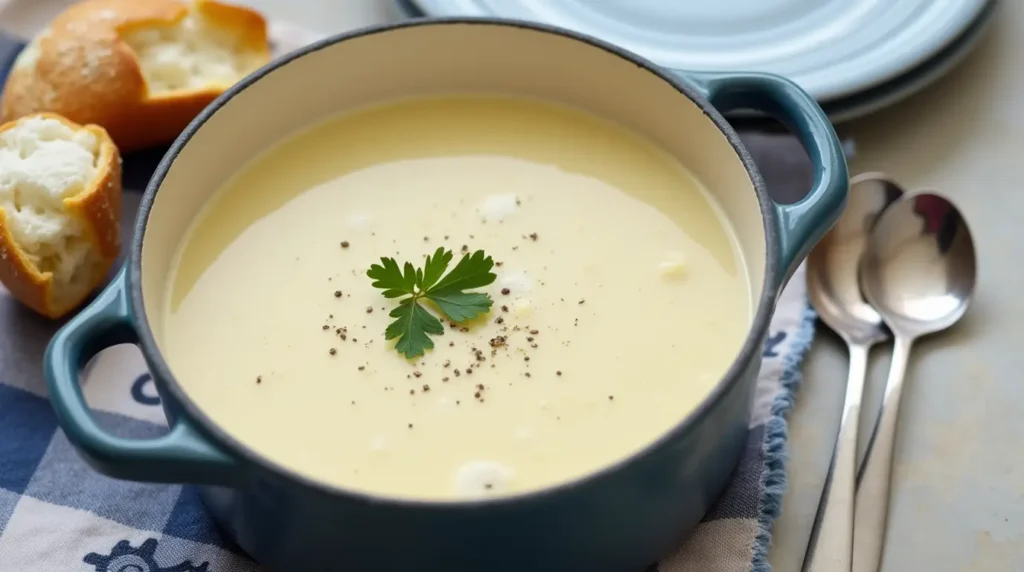
A perfect potato soup needs you to master some basic cooking techniques. Professional approaches with precise cutting methods and careful temperature control will give exceptional results.
Proper Cutting and Sizing Methods
The cutting technique begins when you hold the potato over your cooking pot and use a paring knife to create irregular chunks. Make the pieces wider than thick with jagged and tapered edges. The irregular edges will melt into the broth and naturally thicken it with their starch.
Traditional dicing starts by cutting the potato into strips, then crosswise into ½-inch cubes for medium dice, ¼-inch for small, or ¾-inch for large. You should store cut potatoes in water until ready to use to prevent browning.
Temperature Control Tips
The soup’s consistency depends on proper temperature control throughout cooking. The mixture should reach a light boil over medium heat. You should reduce to low heat and cook for 30-45 minutes until potatoes become fork-tender.
Food safety requires you to heat the soup to 165°F or higher for at least 15 seconds. The minimum temperature should stay at 135°F for hot service.
Achieving the Ideal Texture
Several professional techniques help create the perfect texture:
- Base Preparation
- Cook butter and flour together to form a roux
- Simmer for 2-3 minutes to cook out raw flour taste
- Gradually whisk in broth until well blended
Potatoes naturally break down during cooking and contribute to the soup’s thickness. An immersion blender provides the quickest way to achieve smoother consistency. A stand blender works well too – just let the soup cool slightly before blending in batches.
You can control thickness by removing half the potatoes before blending, then returning them to create textural contrast. Adding water gradually helps reach the desired consistency if the soup becomes too thick. This approach gives you both smoothness and hearty texture in each spoonful.
Chef-Approved Recipe Steps
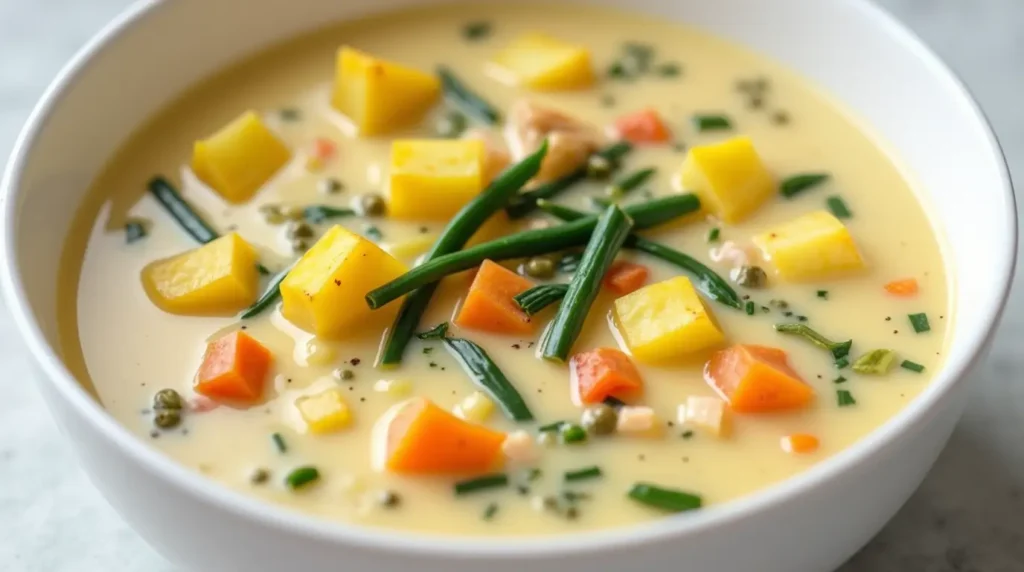
Becoming skilled at potato soup starts with executing professional cooking techniques precisely. Here’s how to turn simple ingredients into a masterpiece using chef-approved steps.
Base Preparation Method
Start by rendering bacon in a large Dutch oven over medium heat until crispy. Save about 3 tablespoons of bacon grease in the pot. Add butter and sauté diced onions until they turn translucent, which takes 3-4 minutes. The minced garlic goes in next – cook it for 30 seconds to release its aroma.
Make a roux by sprinkling flour over the butter-onion mixture. Stir constantly for 2-3 minutes to remove the raw flour taste. This vital step creates the foundations for perfectly thickened soup.
Cooking Process Timeline
- Original Cooking Phase (15-20 minutes):
- Bring mixture to a gentle boil over medium-high heat
- Add diced potatoes and reduce heat to medium-low
- Simmer until potatoes become fork-tender
Gradually pour in the milk mixture while whisking continuously to avoid lumps. The best results come from maintaining a steady simmer instead of a rolling boil. Your potatoes should reach perfect tenderness in 30-45 minutes.
Final Seasoning Adjustments
Take the pot off heat when potatoes reach ideal tenderness. Now add sour cream – doing this off heat prevents curdling. Season with salt and pepper gradually, tasting as you go.
These professional touches will improve depth:
- Smoked paprika adds subtle warmth
- A pinch of cayenne creates gentle heat
- Fresh herbs like thyme or parsley bring brightness
You want a rich and velvety consistency. Use an immersion blender to puree about half the soup while leaving some potato chunks for texture. This will give a smooth yet hearty texture in every spoonful.
Give it one final taste and adjust seasonings before serving, since flavors develop during cooking. Serve the soup piping hot with your favorite toppings.
Common Mistakes to Avoid
You need to become skilled at making potato soup by knowing the common pitfalls that can affect your final result. Here are the challenges and solutions to make your soup turn out perfectly every time.
Temperature Control Errors
The right temperature is vital for both safety and quality. Your potato soup should simmer gently instead of boiling vigorously. Heat your food to 185°F (85°C) for 5 minutes to kill harmful toxins. Keep the soup at a steady temperature to stop curdling, especially when you have dairy products in the mix.
Wrong storage temperatures can lead to serious health risks. Your potato soup needs refrigeration, as shown by two cases where unrefrigerated soup made people severely ill after 42 days and 18 days of poor storage. When reheating, warm the soup gradually to prevent separation.
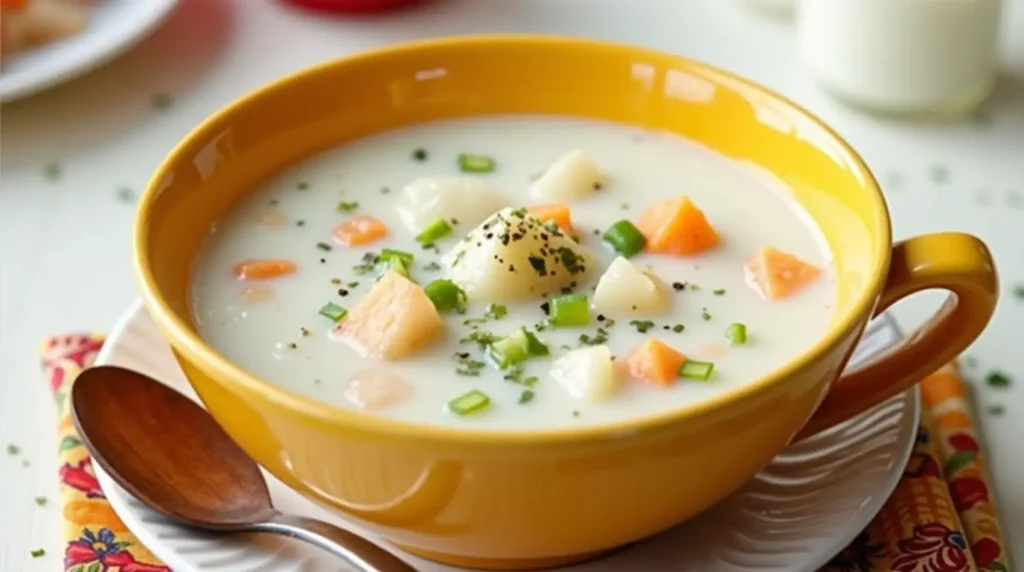
Texture Problems and Solutions
The biggest problem with texture comes from mishandling potatoes. Too much processing releases excess starch and creates a gummy, sticky soup. Here’s how to prevent this:
- Use gentle mashing instead of food processors
- Blend just one-third of the soup for the best texture
- Keep some chunks for better mouthfeel
- Mix in dairy slowly at lower temperatures
Your choice of potato variety makes a substantial difference in texture. Russet potatoes alone can make your soup feel gritty. You’ll get smoother results with waxy varieties like fingerling or red potatoes.
Seasoning Mishaps
Bad seasoning can ruin your potato soup’s flavor profile. Timing matters – add salt early to season the vegetables properly. People often under-season their soup, but you can fix over-salting by adding plain potatoes to soak up extra salt.
Professional chefs suggest these adjustments to balance flavor:
- Add acid (lemon juice or vinegar) for brightness
- Mix in umami elements like parmesan rinds
- Season throughout the cooking process
- Taste and adjust before serving
Note that dairy products change how seasoning works. Cut back on initial seasoning when adding cream or milk since these ingredients thin out flavors. Never taste questionable stored soup to check freshness because this can make you seriously ill.
Storage and Make-Ahead Tips
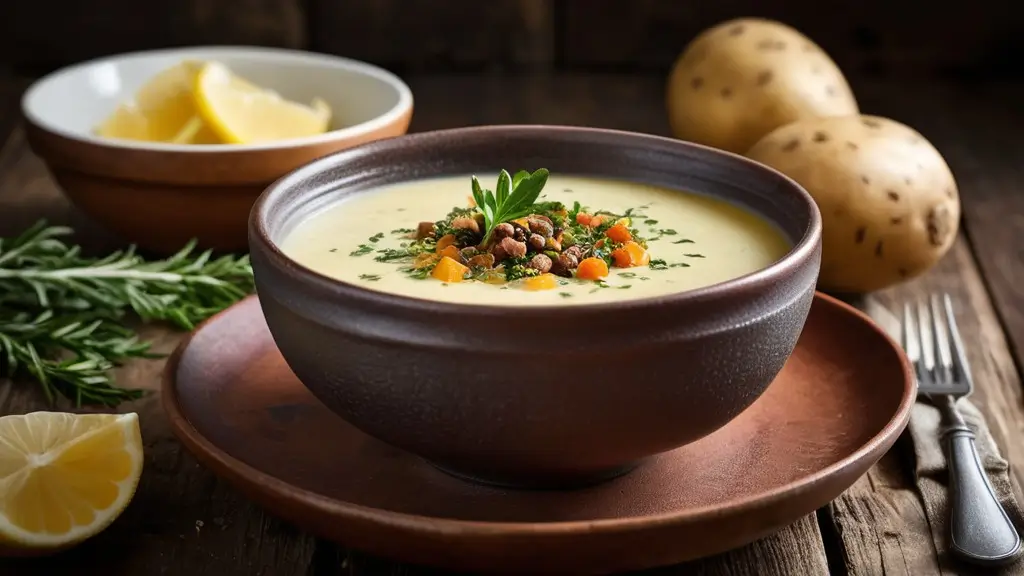
The right storage techniques will give your potato soup lasting quality and safety. We focused on the correct cooling, storage, and reheating methods that help preserve both flavor and texture.
Proper Cooling Methods
Food safety begins with quick cooling. Your potato soup must cool from 140°F to 70°F within 2 hours and reach 40°F within 4 more hours. Here are some quickest ways professional chefs use:
- Put the pot in an ice water bath and stir occasionally
- Split soup into shallow containers (no deeper than 3 inches)
- Add ice as part of your recipe’s liquid measurement
- Get cooling paddles for larger batches
The soup should never cool outdoors or sit at room temperature because temperature changes raise the risk of bacterial growth.
Storage Container Selection
The right containers are vital to keep your soup fresh. Glass containers work better than plastic. Here are some storage guidelines to follow:
Your refrigerated soup stays fresh in airtight containers for 4-5 days. Frozen soup needs about one inch of headspace since liquids expand in the freezer.
Container Tips:
- Pick freezer-safe containers with tight-fitting lids
- Add a layer of wrap right on the soup’s surface
- Write contents and date on containers
- Keep in the deepest part of your freezer
Freezer bags work great for space-saving storage. Put the empty bag in a bowl, fold its edges over the rim, and carefully ladle in the cooled soup.
Reheating Techniques
The right reheating keeps your soup’s texture and flavor intact. Heat it over medium-low heat on the stovetop and stir occasionally. Here are the temperature guidelines to follow:
Microwave Method:Heat in 90-second bursts and stir between each cycle. Cover with a microwave-safe lid or paper towel to stop splattering.
Stovetop Method:Heat slowly over medium-low heat and stir often to prevent burning. Dairy-based soups shouldn’t boil as they might separate.
Slow Cooker Option:Put the ceramic insert in the slow cooker and heat on low for 1-2 hours.
Thick soups tend to get thicker in storage. Mix in some broth, milk, or half-and-half while reheating until it looks right. Frozen soup should thaw overnight in your refrigerator before reheating.
Note that dairy-based potato soups might separate when frozen. You’ll get better results if you freeze the base without cream and add fresh cream during reheating. This approach will give your homemade potato soup that creamy texture and rich flavor you want.
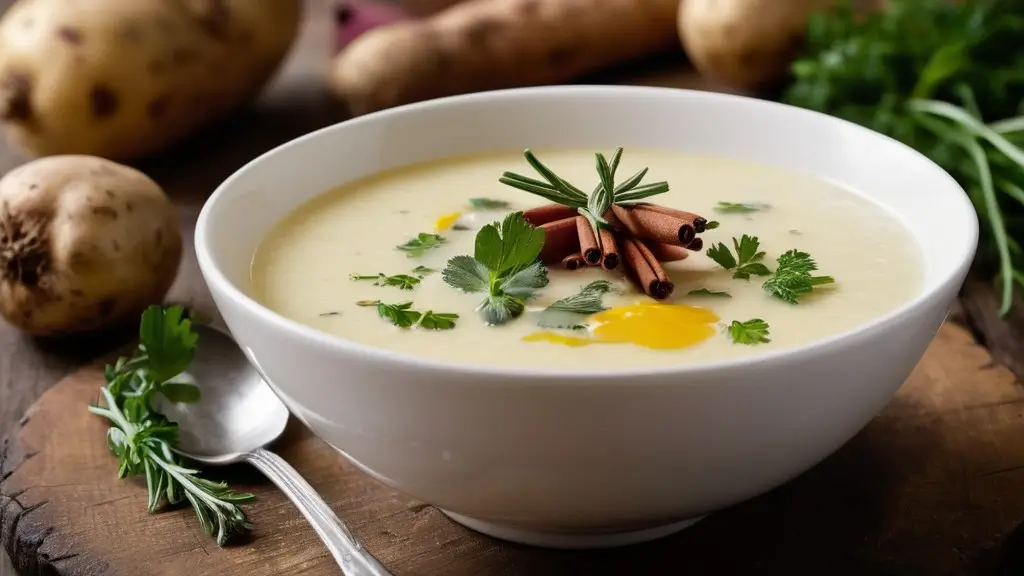
Conclusion
Creating perfect potato soup demands attention to detail and professional techniques that start with selecting the right potatoes. Anyone can create this comforting dish at home by controlling temperature and handling ingredients properly.
Note that outstanding results depend on several factors: high-quality ingredients, consistent cooking temperatures, and avoiding common mistakes like over-processing potatoes. Your soup will stay fresh and delicious for future meals with proper storage techniques.
This versatile dish adapts to your taste preferences – from chunky rustic style to smooth creamy texture. Proper storage techniques will keep your leftover soup fresh and comforting for days. You can find more delicious recipes and food ideas in this piece at recipesnutritious.com.
These chef-approved techniques and tips will help you create restaurant-quality potato soup in your kitchen. The possibilities are endless when you experiment with different toppings and share this classic comfort food with your family.
FAQs
Q1. What’s the best way to thicken potato soup? The starch from the potatoes naturally helps thicken the soup. Additionally, you can whisk together flour and milk to add body. Using heavy cream also contributes to a thicker consistency.
Q2. How can I enhance the flavor of canned potato soup? To improve canned potato soup, add milk or water, frozen corn, and herbs like basil and oregano. Garlic and onion powder can also boost flavor. For a thicker texture, add some mashed potatoes.
Q3. What’s a surprising ingredient that can enhance soup flavor? Vinegar is a secret ingredient that can significantly enhance soup flavor. It acts as a flavor enhancer (umami) and is often used in small amounts to brighten and balance the taste of soups.
Q4. How do I prevent potatoes from becoming mushy in soup? To keep potatoes from getting mushy, add a small amount of vinegar (white, wine, or cider) to the cooking water. This helps maintain the potato’s structure. Remember to rinse the potatoes afterward to remove any vinegar taste.
Q5. What are some professional tips for achieving the perfect potato soup texture? For ideal texture, use an immersion blender to puree about half the soup, leaving some potato chunks for interest. Alternatively, remove half the potatoes before blending, then return them to create textural contrast. If the soup becomes too thick, gradually add water until reaching the desired consistency.

